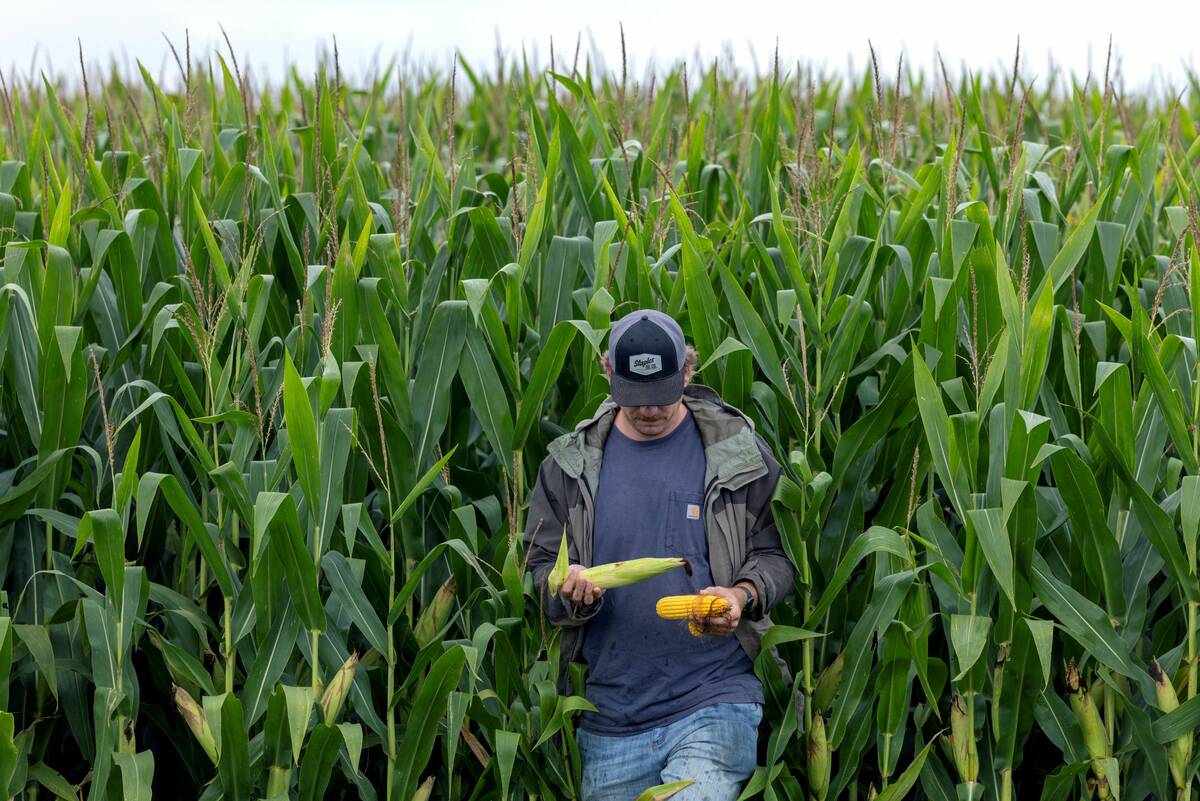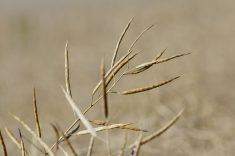Updated, Sept. 22 — The maker of Odyssey, Solo and Viper is warning grain growers whose fields were excessively dry in 2021 that those herbicides may not break down soon enough in those soils to allow certain seeding choices in 2022.
BASF Canada on Monday issued an “urgent notice to growers” in which the company provided a list of new “agronomic recommendations” for users of its three imidazoline (“imi”) Group 2 herbicide lines.
Read Also

The U.S. corn crop could be the biggest ever. That’s terrible news for America’s farmers.
The USDA predicts a record corn crop for U.S. farmers, who question the agency’s accuracy amidst high debt and low crop prices.
“We all know that certain environmental conditions can delay the breakdown of herbicide residues in soil. But this year is different,” BASF Agricultural Solutions Canada’s technical solutions manager Jeff Bertholet wrote in the email notice, referring to widespread drought across Western Canada.
“Our research shows that in seasons where there has not been an adequate amount of rainfall throughout the season to facilitate herbicide breakdown in the soil, injury to more sensitive rotational crops is likely to occur.”
The current product labels for Odyssey, Solo and Viper herbicides already include lists of “follow crops” that may or shouldn’t be planted following a crop year in which the imi chemicals were applied.
However, Bertholet wrote last week, the research points to “a high degree of risk of injury for sensitive crops, such as canola, durum wheat and canary seed.”
BASF thus recommends growers in the dark brown, black, grey or grey wooded soil zones whose fields received less than 125 mm of accumulated rainfall between June 1 and Sept. 1 this year should not plant canola, durum wheat or canary seed in 2022 if they applied Solo ADV, Solo Ultra or Viper ADV on those fields in 2021.
In those same four soil zones, growers who applied Odyssey NXT, Odyssey Ultra or Odyssey Ultra NXT in 2021 should not seed durum or canary seed on those fields in 2022.
Also, if they applied Odyssey NXT, Odyssey Ultra or Odyssey Ultra NXT on those fields in 2020, they should not grow non-Clearfield canola on those fields in 2022 either. Clearfield seeds are bred for tolerance to imi herbicides.
Meanwhile, growers who farm in the brown soil zone and whose fields got less than 125 mm of accumulated rainfall between June 1 and Sept. 1 this year — and those who received less than 15 mm of rainfall in any of the months of June, July or August this year, regardless of total accumulated rainfall in that three-month period — should not plant canola, durum wheat or canary seed in 2022 if they applied Solo ADV, Solo Ultra or Viper ADV on those fields in 2021.
Also in the brown zone, under the same moisture conditions, growers who applied Odyssey NXT, Odyssey Ultra or Odyssey Ultra NXT in 2021 should not seed durum or canary seed on those fields in 2022.
Also, if growers in that zone applied Odyssey NXT, Odyssey Ultra or Odyssey Ultra NXT in 2020, they should not seed non-Clearfield canola on those fields in 2022.
A company representative noted in an email response to GFM Wednesday that the company has sent out similar notices in previous growing seasons with limited rainfall.
Given this summer’s drought and heat, though, “the risk of crop injury in 2022 is the most extreme that we have observed, and we think that injury is no longer just a risk but a high probability,” the company said.
‘Not supporting’
Due to the “extreme risk of crop injury” in those cases, BASF “will not be supporting” canola, durum or canary seed as follow crops for the 2022 season “if these recommendations are not followed,” the company said in its notice to growers.
In other words, the company said later, if a grower chooses to ignore or not follow its recommendations after receiving the notice, he or she “will not be eligible for coverage under our product performance assurance policies.”
Growers whose fields “meet or exceed the necessary rainfall requirements as outlined in our notice” would still receive support under those policies similar to previous years.
Furthermore, BASF said, growers in dry regions still can seek support if need be for “labelled rotational crops not listed in the notice of risk” — crops such as, say, spring wheat or barley.
Solo ADV is an imazamox herbicide, while Odyssey NXT is a combination of imazamox and imazethapyr. Viper ADV combines imazamox with bentazon, the Group 6 active ingredient in Basagran. Odyssey Ultra, Odyssey Ultra NXT and Solo Ultra combine their respective actives with sethoxydim, the Group 1 active ingredient in Poast.
On its imi herbicide labels, BASF has said “certain environmental conditions” such as drought, excessive cold and extremes in soil pH may delay breakdown of herbicide residues in soil, leading to “increased potential for injury to succeeding crops to occur.”
That potential, the company said, is a property of herbicides that persist in soil and depend on soil microbial activity and non-microbial processes such as hydrolysis to break down.
The product labels for Solo ADV and Viper ADV on BASF’s website still say durum, canary seed or non-Clearfield canola, among some other crops, can be grown safely as follow crops in the year after those products were applied.
The Odyssey NXT label, meanwhile, says studies show crops that may be safely planted in the year after an application include durum and canary seed as well as spring barley, spring wheat, chickpeas, field corn, lentils, dried field peas, soybeans, oats, Clearfield canola and Clearfield lentils.
On the same label, however, the wait to seed flax, non-Clearfield canola or non-Clearfield sunflower is two years following Odyssey NXT application, in almost all regions of Western Canada.
The label exception is the Peace region of Alberta, where the recropping interval for those three crops is “a minimum” of 34 months — and growers there first need to run a field bio-assay a year ahead of time, to confirm “normal growth.”
Corteva, whose imi herbicide Ares SN is a combination of imazamox and imazapyr, has similar text about “certain environmental conditions” on that product’s label.
For Ares — a brand BASF sold to Corteva in 2019, along with the Clearfield Canola Production System — the label now posted on Corteva Canada’s website calls for two years after application before planting non-Clearfield canola, durum, flax or sunflower.
The same label says crops such as canary seed, chickpeas, field peas, field corn, Clearfield canola, lentils (including Clearfield), spring wheat (including Clearfield) or spring barley may be planted one year after application of Ares.
‘Unprecedented’
Concerns about imi herbicide carryover in Prairie crops have been aired in previous dry years.
In a March 2019 article on Cargill’s website, company agronomist Amy Chomyshen reported canola growers in her central Saskatchewan region saw “delayed, weak” canola seedlings in the spring of 2018 in fields where imi herbicides were applied in 2017.
During the relevant three-month period in 2017, the region “did not receive much, if any, rainfall” and the dry season caused the herbicides to carry over to the following spring without breaking down, she wrote.
She thus recommended growers who sprayed imazamox on pulses in the dry 2018 season plan on seeding those fields to a cereal crop or Clearfield canola the following spring.
The breakdown process for most herbicides — including but not limited to the imis — is “primarily driven by microbial degradation within the soil,” BASF said via email Wednesday. “Microbial populations require a hospitable soil environment with moist, warm soils to break down herbicide residues.”
Thus, in seasons where growers experience drought, injury may be seen in “more sensitive” crops seeded the following season — even when the label directions for recrops are followed — as product labels “are not developed under extreme environmental conditions.”
And in a “historically unprecedented” year such as 2021, BASF said, for herbicides with “persistent characteristics,” it may be necessary to extend the label-listed rotational crop options by a year when “adequate herbicide degradation would not have occurred.” — Glacier FarmMedia Network
— Article updated Sept. 22 to include comment from BASF.













